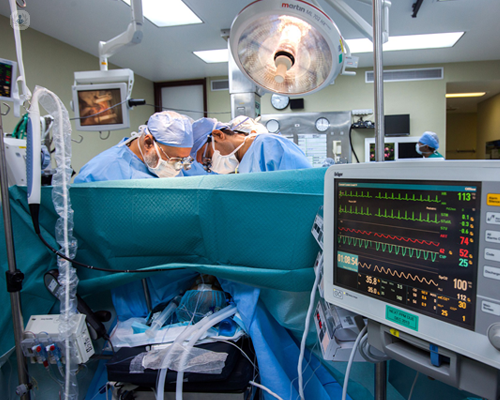Emergency surgery
What is emergency surgery?
Emergency surgery is when immediate, unplanned action needs to be taken after a patient has become seriously ill, badly injured or not breathing. It's done in order to save a patient's life or to deal with severe threat to organs, limbs or tissue.

What type of conditions require emergency surgery?
Emergency surgery can apply to various conditions. These include:
- Severe trauma to the head, chest and abdomen alongside different part of the body like the eyes, ears or limbs including extremities like hands and feet
- Serious burns
- Acute respiratory failure
- Cardiac emergencies like heart attacks, cardiac shock and cardiac arrhythmia
- Aneurysms
- Neurological conditions
- Abdominal conditions like perforated ulcers, appendicitis and cholecystitis (gallbladder infection) or blockage in the bowel
Sometimes people come to hospital reporting a complaint and don't realise they may need emergency treatment. For example they may report heart problem symptoms and may be having a 'silent heart attack'.
How is emergency surgery assessed?
Emergency surgery is assessed when the patient arrives at the emergency room of the hospital. Highly-trained staff will assess the person's condition, which includes:
- Taking vital signs
- Reviewing symptoms
- Physical examination
- Taking a history of past and present conditions, allergies and medication use
Emergency treatment may begin straightaway alongside assessment, if the patient is critically ill. They may need to be stablised with:
- Medicine
- Transfusion
- Intravenous fluid
After the patient has been stablised, diagnostic tests may been to be performed depending on the situation. These tests include:
- X-rays
- Laboratory work
- Computed tomography scan (CT scan)
- Magnetic resonance imaging (MRI) scans
- Electrocardiograms (ECGs)
- Electroencephalograms (EEGs), which assess brain injuries
If tests confirm surgery is needed, a trauma or general surgeon will be immediately consulted. They are usually available 24 hours a day in larger hospitals and normally perform their own assessment in the emergency room.
Depending on the facilities that the hospital offers, the emergency room may need to coordinate a transfer once the patient is stabilised. This is typically within an hour or less and can involve an ambulance or helicopter with trained staff onboard.
What happens in emergency surgery?
General anaesthesia is given during emergency surgery. While this is happening, an endotracheal tube is placed in the windpipe and connected to a ventilator, which takes over the respiration for patient during surgery. In order to prevent any movement and that the patient sleeps through the procedure, other medications are given.
The illness or condition the patient has will dictate the type of emergency surgery required, amount of surgeons needed and how long the operation will take. Transfusions may also have to take place during the procedure in order to keep the patient stable throughout. IV (intravenous drip) fluids are also given to make up for any blood loss and body fluids.
What is involved in recovery from emergency surgery?
If the patient is stable, they will be monitored after completion of the emergency surgery, in the post-anaesthesia care unit (PACU). Once anaesthesia has worn off, they will be taken to a hospital room to begin healing.
Antibiotics to prevent infection and pain medication are administered. If a patient is too sick to eat, a feeding tube may be inserted into the stomach or small intestine or nutrition is delivered by IV. Once the patient is strong enough, they will be able to sip small amounts of clear liquids and gradually move on to a normal diet.
If monitoring is still needed or the patient is unstable, they will be taken to intensive care (ICU). Those with critical injuries may need to remain on a ventilator until they are strong enough to breathe without assistance. Additional surgeries, medical procedures and/or rehabilitation therapy may also be required.
Once the medical staff responsible for the patient are satisfied that the person is recovered, the hospital discharge procedure will start. Home help may be required to assist with the transition or provide ongoing health assistance.
Which specialist performs emergency surgery?
Trauma surgeons, also known as critical care or acute care surgeons, perform emergency surgery. They have an extensive knowledge of surgical procedures and management of different types of injuries.
